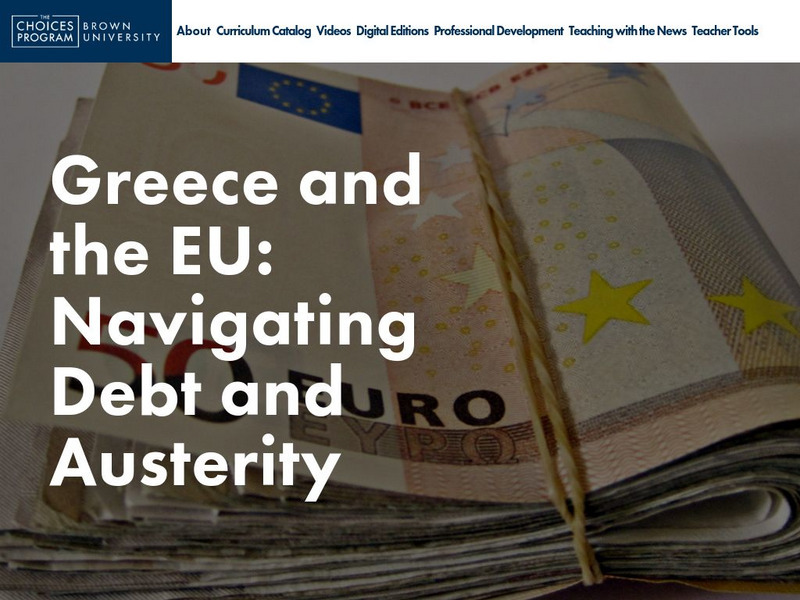State of Victoria
Making Healthy Choices, Making Healthy Food: PreK-3 Curriculum Support
From examining how much sugar is in foods and looking at fruit and vegetable varieties to making mini rainbow tarts, this unit provides youngsters with a fabulous overview of proper nutrition and eating habits.
CCEA
Home Economics: Teen Building
Learners explore the emotional and nutritional needs of teenagers in a six-lesson unit, which covers such topics as food sources, cooking skills, emotional well-being, and the positive effect of food and family occasions.
Wells Fargo
Hands on Banking
What happens to your money between the time you make a bank deposit and the time you decide to spend it? Take middle schoolers and teens through the process of opening checking and savings accounts, creating a personal budget,...
American Institute of Architects
Architecture: It's Elementary!—Fifth Grade
Young citizens construct an understanding of urban planning in this cross-curricular unit. Covering every aspect of city development from the political, economic, and social influences to sustainable building practices, this...
Practical Money Skills
Buying a Home
Guide high schoolers through the process of buying a house with a simulation lesson. As pupils learn about mortgages, renting versus buying, and home inspections, they discuss ways to make informed financial decisions and sound...
Junior Achievement
Community and Economy
What does it take to make a town run smoothly each and every day? Scholars create their own Biztown with hands-on interactive activities. Using games, demonstrations, and decision-making skills, they learn what resources they need for a...
State of Victoria
Making Healthy Choices, Making Healthy Food: 4-6 Curriculum Support
How much water should we drink every day? How can food preparation be both healthy and satisfying? Check out this great 10-lesson unit which not only covers the body's need for water, but also includes lessons on tasting and storing...
North Carolina Department of Public Instruction
What Is A Bank?
You're never too young to learn about banking and personal finance. Use a set of seven banking lessons to teach middle schoolers about checking and savings accounts, interest rates, loans and credit cards, and safety deposit boxes.
Core Knowledge Foundation
Genetics and the Master Race
How did the beginnings of genetic research influence the Nazi party? A thorough, engaging unit incorporates the work of Gregor Mendel, the study of inherited traits, and the use of racism and discrimination during the Holocaust.
Wells Fargo
Hands on Banking
Encourage middle schoolers to be proficient and knowledgeable in the economic world with a series of personal finance lessons. Focusing on banking, credit, budgets, and investing, the activities guide learners through financial...
Northern Ireland Curriculum
Money Wise
Does money seem to slip through your middle schoolers' fingers? Encourage them to examine spending, saving, and budgeting habits with a unit on consumer skills and money management. Young spenders study the waste that occurs with school...
Los Angeles Unified School District
Capitalism and Socialism
Capitalism, socialism, communism ... these may seem like a whole bunch of isms to your scholars. High schoolers won't confuse them after completing an informative resource. Your class masters how to use primary sources to...
Northern Ireland Curriculum
Festivals: Learning for Life and Work
How do different communities celebrate special occasions? After researching celebrations in their countries, class members investigate other festivals like those associated with Ramadan, Diwali, Chinese New Year, Halloween, Easter,...
Math Solutions
Cooking Up Chicken
Although designed for career education classes by the Chicken Farmers of Saskatchewan, the information contained in this 46-page booklet is appropriate for cooking classes and individual chicken consumers. Everything you wanted to...
C3 Teachers
C3 Teachers: Inquiries: Economic Choices
A learning module on choices people make with their money. It includes several supporting questions accompanied by formative tasks and source materials, followed by a summative performance task. Students will learn how families get...
Texas Education Agency
Texas Gateway: Chapter 2: Choice in a World of Scarcity: Key Concepts & Summary
This section focuses on the key concepts and a summary of macroeconomics covered in Chapter 2: Choice in a World of Scarcity from the TEA AP Macroeconomics.
Choices Program, Brown University
Choices: Greece and the Eu: Navigating Debt and Austerity
Multi-media resources including video, handouts, and readings for students learning about the effects of the 2008 financial crisis in Greece and the European Economic Eurozone.
Choices Program, Brown University
Choices: Teaching With the News: The Costs of War
Learning module with scholars online video and readings with which to explore the human, economic, social, and political costs of the wars in Iraq and Afghanistan.
Georgia Department of Education
Ga Virtual Learning: Economics: Personal Finance
Economics learning module on personal finance discusses decision making, banking and using credit.
Texas Education Agency
Texas Gateway: Macroeconomics: Confronting Objections to the Economics Approach
By the end of this section, you will be able to analyze arguments against economic approaches to decision-making, interpret a trade-off diagram, and contrast normative statements and positive statements.
Khan Academy
Khan Academy: The Production Possibilities Frontier
The Production Possibilities Frontier (PPF) is a graph that shows all the different combinations of output of two goods that can be produced using available resources and technology. The PPF captures the concepts of scarcity, choice, and...
Other
South Western Learning: Econ News: Externalities, Market Failure, Public Choice
This study guide distinguishes between positive and negative externalities and how to correct negative externalities. Some learning exercises and an online quiz are also provided.
Khan Academy
Khan Academy: Decisions Within a Budget Constraint
Another approach to maximizing utility uses indifference curves (sometimes called utility curves) and budget constraints to identify the utility optimizing combination of consumption. Read about this method in this article.
TED Talks
Ted: Ted Ed: Social Animal
Tapping into the findings of his latest book, NYTimes columnist David Brooks unpacks new insights into human nature from the cognitive sciences- insights with massive implications for economics and politics as well as our own...























